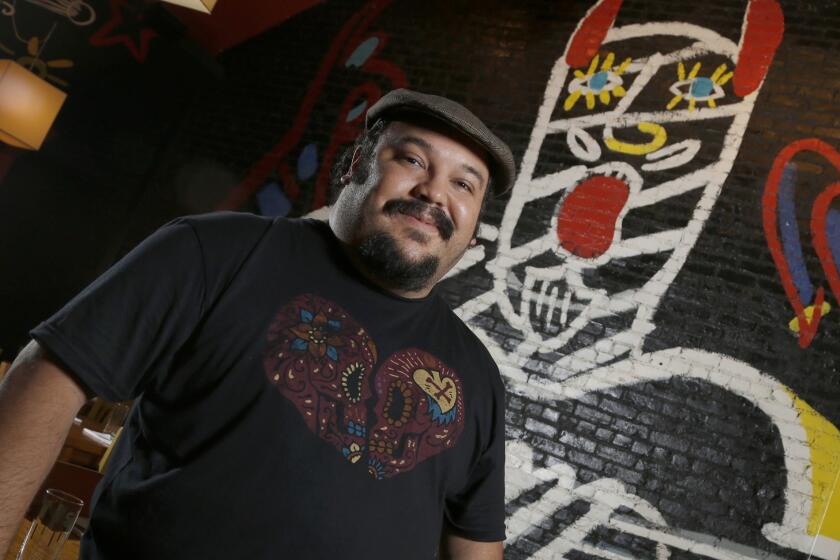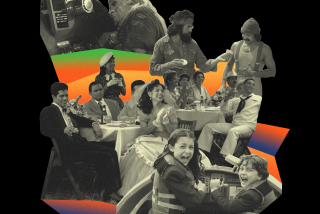New Netflix animated show ‘Maya and the Three’ has a grand design
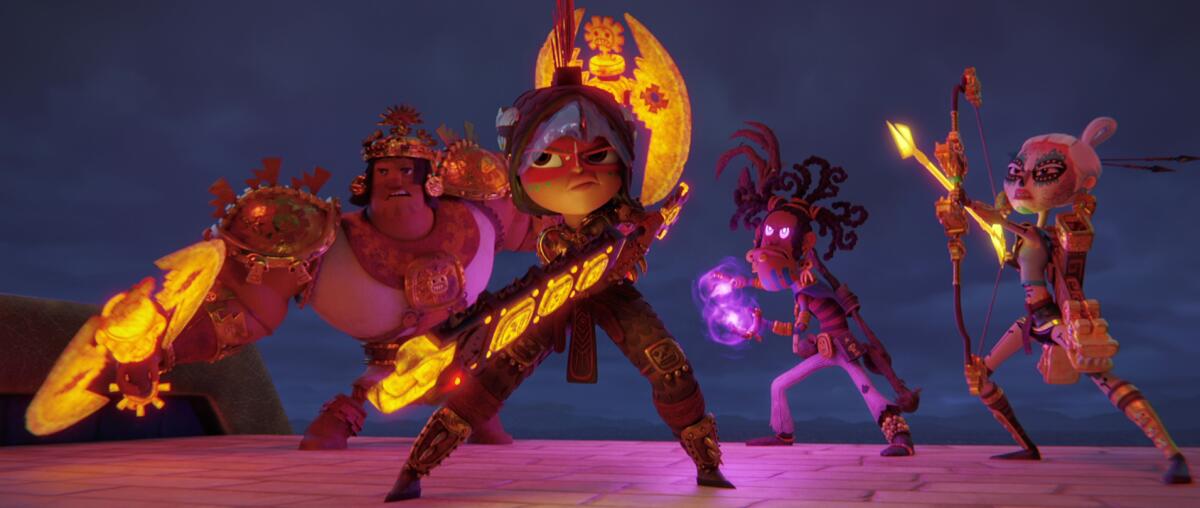
- Share via
“Maya and the Three,” which premieres Friday on Netflix, is a big, animated epic from Jorge R. Gutiérrez, whose earlier works include the 2014 feature “The Book of Life” and the 2007 Nickelodeon series “El Tigre: The Adventures of Manny Rivera.” Fans of either will find themselves at home in this Mesoamerican epic, with its mix of folkloric motifs, comedy and anime-derived action; fans of both should be filled with joy. It’s been too long an absence for a singular talent.
Spread out over nine episodes, “Maya” is a sprawling affair with intricately worked out action and a digressive plot. Yet one feels — though it can’t actually be the case given that it takes a heap of help to make an animated feature — that the route from sketchbook to screen was a short one. Its eccentricities, even its occasional awkwardness, are not distinct from its poetry. To say it can be a little corny and sentimental, though usually with a joke to pull things back from the brink of mawkishness, is only to say it has heart; in any case, it worked on me visually and emotionally, as thoroughly on a second viewing as on the first. (And it’s worth a rewatch to get a better sense of the elaborate design and to pick up bits of the story you may have been missed while looking at the pictures. There is a lot to keep track of.)
First the streaming wars. Then COVID-19. It’s been a rocky time for TV, but executives and creatives alike say adult animation is enjoying a ‘renaissance.’
As the tale begins in some unspecified time long ago, Maya (Zoe Saldaña, who was also in “The Book of Life”) is turning 15 and about to be officially crowned princess of the kingdom of Teca, as in Azteca. (A brief passage involving an eagle, a snake and a prickly pear nods to the legendary founding of Tenochtitlan, the ancient forerunner of Mexico City.) Although she is being groomed to be a diplomat like her mother (Sandra Equihua, Gutierrez’s wife and collaborator), Maya envies her amiable but dim brothers’ (all played by Gael García Bernal) quests and adventures.
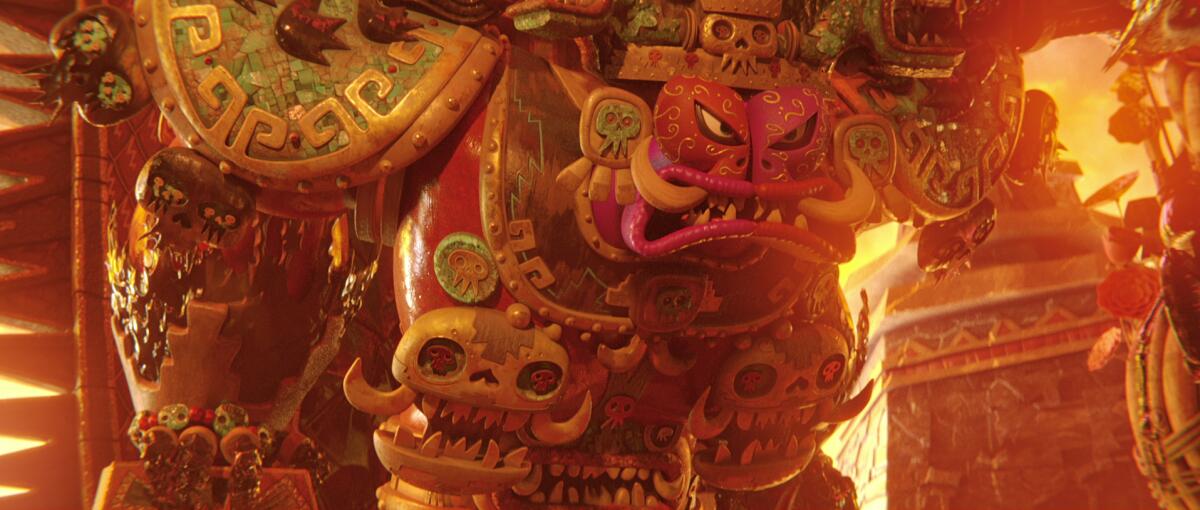
So she sneaks out at night to the “illegal bare-knuckle fighting pit” to take on an opponent 20 times her size; she’s got spunk, but she’s also a bit of a bratty teenager. (There is a lot of fighting in the series, both as battle and, eventually, as courtship, in the way that Fred and Ginger didn’t get along until they danced together — among other things, this is a teen romance.)
Maya’s trip to the fighting pit wins her only a dislocated shoulder; the coronation goes ahead, attended by representatives of the story’s three other kingdoms. But it is interrupted by Zatz (Diego Luna), the Prince of Bats, a good-looking kid up from the underworld who drops a bomb regarding Maya’s true parentage. The prince announces that he’s come to take her to her “rightful kingdom in the underworld,” where she will be sacrificed, as casually as if he were announcing that he remembered to pick up milk while he was at the grocery store. (Her birth mother — mild spoiler — is Lady Micte, the Goddess of Death, played by Kate del Castillo; family is a repeating theme here.)
Things go their complicated way, with puzzles to solve and prophecies to interpret or misinterpret. After Maya’s excitable father (voiced by Gutiérrez himself) fails to crush the forces of power-hungry Lord Mictlan, the God of War (Alfred Molina), the daughter journeys to the other kingdoms, picking up allies on the way like Dorothy on the yellow brick road. All are damaged in some way or have wreaked accidental destruction on their community or family and are living apart: From the Jungle Lands comes Chimi (Stephanie Beatriz), a gifted archer who decorates her pale face like a Day of the Dead figure and longs to apologize to the mother who died giving her birth; from the Caribbean-influenced Luna Island, Rico (Allen Maldonado), a street kid looked down upon for his “peasant magic”; and from the Golden Mountains, which might be meant to suggest the Andes, Picchu the soft-hearted barbarian (Gabriel Iglesias). Each gets a backstory. There is also Maya’s big pet jaguar, Chiapa, who is a pussycat.
“I’m the Eagle Warrior to lead them all,” declares Maya, who can be a little too sure of herself.
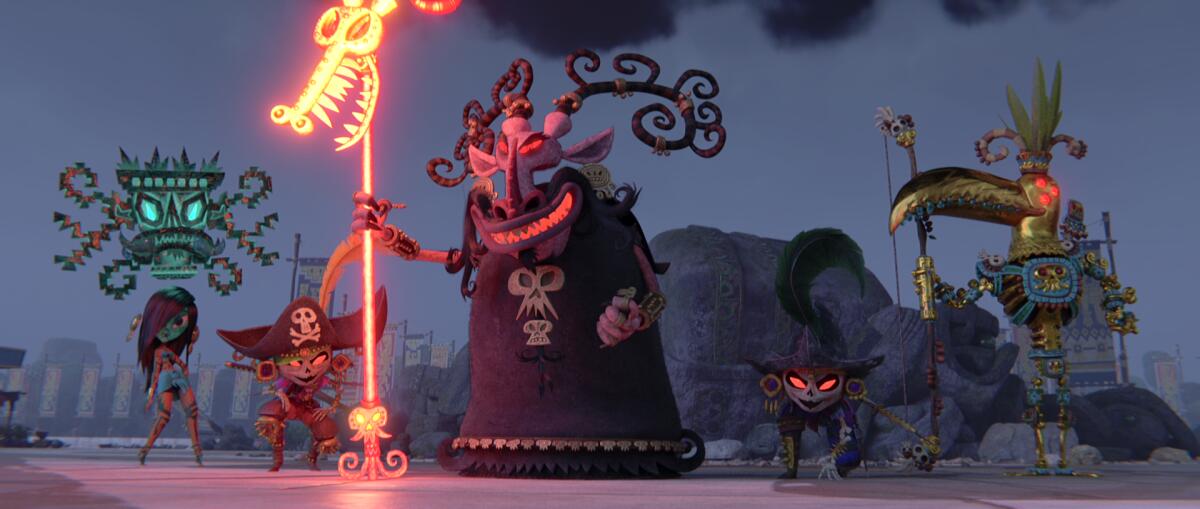
Gutiérrez, who was born in Mexico City and grew up in Tijuana before studying animation at CalArts, has taken a host of Aztec and Mayan deities as inspirations and bent them to his own purposes; this is not a cartoon translation of the Popol Vuh, which is nothing you would want to show your kids anyway. Rather, he’s built an original world from the anthropological, architectural, topographical and mythological details of various Mesoamerican civilizations. (He leaves out the human sacrifice, except in the sense of self-sacrifice.) His gods are more like “Batman” villains, with their thematic design, powers and obsessions, and announced with title cards (a device the animator used in “El Tigre”). Danny Trejo, Cheech Marin, Rosie Perez and Eric Bauza are among the actors providing their voices. Also here are Queen Latifah and Wyclef Jean as Luna Island royalty and Rita Moreno as a mysterious, slightly mad good witch, Ah Puch, who pops up everywhere. It’s a starry production.
Face sweating, heart pounding, Jorge Gutierrez began to deliver the worst pitch of his career.
Like Patrick McHale’s “Over the Garden Wall,” Elizabeth Ito’s “City of Ghosts,” Craig McCracken’s “Kid Cosmic,” Pen Ward and Duncan Trussell’s “The Midnight Gospel” and Gutierrez’s own “The Book of Life,” “Maya and the Three” feels personal — an outsider, like its heroes. Big studio cartoon features, though they may work exceedingly well, can often feel scrubbed and massaged and anonymous, one looking and feeling and sounding much like another. Computer animation, especially, tends toward sameness, to the erasure of the artist’s hand in favor of “naturalism.” Gutiérrez fights this with crazy, busy, baroque design, otherworldly palettes, inventive wipes, split screens and 2-D interludes; most every character is elaborately armored or adorned, and those familiar with his work will recognize his whimsical approach to noses. And though the image is letterboxed for a widescreen effect, the action will sometimes break out into the black bars above or below the frame, as if it just can’t be contained.
There is something, not, naive, exactly, about “Maya and the Three,” but a willingness to be off a little — to dare to be a little dumb on the one hand and heavy on the other. There are joking references to “Raiders of the Lost Ark,” “Jaws,” “Lord of the Rings,” Mr. T. and the Smiths (“To die by your side would be such a heavenly way to die,” says Rico to Chimi, stealing a line from 1985); there is a Spanglish Batman joke. But the series is also full of death and darkness, and no less moving for being set in a world where death is not the end. Quite the opposite: the story bends toward transcendence — and gets there.
More to Read
The complete guide to home viewing
Get Screen Gab for everything about the TV shows and streaming movies everyone’s talking about.
You may occasionally receive promotional content from the Los Angeles Times.
